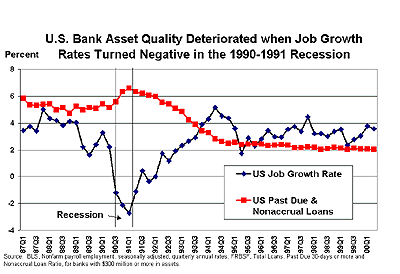Credit Cycles
If only Dr. Econ had the definitive answer on the arrival of the next credit cycle! Credit cycles may affect all types of financial market participants, from borrowers to lenders, from financial institutions to households and the corporate sector. Since the Federal Reserve is a primary banking industry regulator, I’ll answer your question with an eye toward movements in asset quality in the banking industry.
Banking regulators have expressed concerns about potential deterioration in credit standards and lending terms over the past couple of years, despite strong economic growth during that period. Regulators and bankers are well aware that historically, most problem loans–loans that are past due or on nonaccrual status (no longer accruing interest)–were made during good economic times. Given the robust economy in 2000, asset quality through 2000-Q2 at large banks remains strong by historic standards for total loans, real estate loans, and commercial and industrial loans.
Changes in asset quality are an important indicator of banking industry performance that often result in changes in banks’ lending standards. The availability of credit over the business cycle also is affected by changing lending terms and standards; looser lending standards tend to increase the supply of credit, while tighter lending standards tend to reduce the supply of credit. You may track movements in banks’ lending standards by reviewing the quarterly results of the Federal Reserve’s Senior Loan Officer Opinion Survey on Bank Lending Practices: http://www.federalreserve.gov/boarddocs/SnLoanSurvey/
Asset quality changes that take place over the credit cycle at banks are typically measured by problem loan ratios–the percentage of loans of a particular type that are either past due or nonaccrual. Those ratios tend to move ‘inversely’ with the movements in the overall economy, both at the national and state level. This relationship can be seen in the chart, which plots quarterly U.S. job growth rates and quarterly bank problem loan ratios from the late 1980s until 2000-Q2. Thus, one key to examining the health of a bank’s loan portfolio is likely to be the overall condition of the economy in the bank’s market area (national, state, or local). Another key to a bank’s risk exposure may be its portfolio composition, i.e., whether its loan portfolio is highly concentrated in potentially higher-risk loans, for example, construction and development lending or subprime consumer loans.

The experience of small banks in California in the early 1990s illustrates how the economy and portfolio exposure worked together during that period to reduce asset quality. Zimmerman (1996) noted several key factors in an FRBSF Economic Letter on credit cycle problems in California: /econrsrch/wklyltr/wl9604.html#impact
The sub-par performance of many community banks in California is a continuation of the difficulties many small banks have struggled with since the 1990-1991 recession. Two of the most important factors for their performance have been the severity of regional economic conditions in the state and their earlier decisions to move away from a more diversified loan portfolio and into more commercial real estate financing.
Looking forward, it is important to continue to evaluate economic conditions and banking portfolio risks, as well as examine other potential emerging risk areas. Those risks might include susceptibility to downturns in the bank’s market area or key industries and potential risks arising from portfolio concentrations, especially in high-risk lending or other financial activities.
References
Schlesinger, Jacob M. “Greenspan Says Lenders May Be Growing Lax.” Wall Street Journal, Thursday, March 9, 2000.
Zimmerman, Gary C. 1996. “California’s Community Banks in the 1990s.” FRBSF Economic Letter, Number 1996-04, (January 26). (/econrsrch/wklyltr/wl9604.html#impact)
Zimmerman, Gary C. 1996. “Factors Influencing Community Bank Performance in California.” Economic Review, Federal Reserve Bank of San Francisco, 1996 Number 1. (/econrsrch/econrev/96-1/26-42.pdf)
The following web-site provides the most recent summary of banking industry performance for the nation: FDIC’s Quarterly Banking Profile. (http://www2.fdic.gov/qbp/)